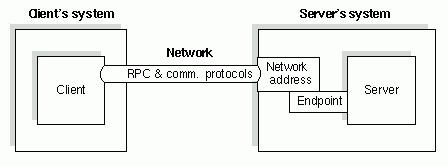
Binding information includes a set of information that identifies a server to a client or a client to a server. Each instance of binding information contains all or part of a single address. The RPC runtime maintains binding information for RPC servers and clients. To make a specific instance of locally maintained binding information available to a given server or client, the runtime creates a local reference known as a binding handle. Servers and clients use binding handles to refer to binding information in runtime calls or remote procedure calls. A server obtains a complete list of its binding handles from its RPC runtime. A client obtains one binding handle at a time from its RPC runtime. The following figure illustrates a binding.
A Binding

Binding information includes the following components:
· Protocol sequence
A valid combination of communications protocols presented by the runtime as a character string. Each protocol sequence includes a network protocol, a transport protocol, and an RPC protocol that works with them.
An RPC server tells the runtime which protocol sequences to use when listening for calls to the server, and its binding information contains those protocol sequences.
· Network addressing information
Includes the network address and the endpoint of a server.
- The network address identifies a specific host system on a network. The format of the address depends on the network protocol portion of the protocol sequence.
- The endpoint acts as the address of a specific server instance within the host system. The format of the endpoint depends on the transport protocol portion of the protocol sequence. For each protocol sequence a server instance uses, it requires a unique endpoint. A given endpoint can be used by only one server per system, assigned by the local system on a first-come, first-served basis.
· Transfer Syntax
The server's RPC runtime must use a transfer syntax that matches one used by the client's RPC runtime. A transfer syntax is a set of encoding rules used for the network transmission of data and the conversion to and from different local data representations. A shared transfer syntax enables communications between systems that represent local data differently. DCE RPC currently uses a single transfer syntax, Network Data Representation (NDR). NDR encodes data into a byte stream for transmission over a network. A transfer syntax such as NDR enables machines with different formats to exchange data successfully. (The DCE RPC communications protocols support the negotiation of transfer syntax. However, at present, the outcome of a transfer-syntax negotiation is always NDR.)
· RPC protocol version numbers
The client and server runtimes must use compatible versions of the RPC protocol specified by the client in the protocol sequence. The major version number of the RPC protocol used by the server must equal the specified major version number. The minor version number of the RPC protocol used by the server must be greater than or equal to the specified minor version number.
More:
How Clients Obtain Server Binding Information
Client Binding Information for Servers